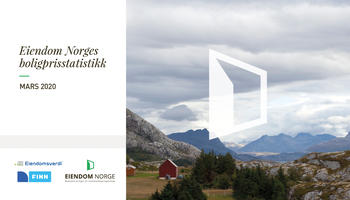
Strong rise in house prices in February
House prices rose by 1.4 per cent in February 2024. Adjusted for seasonal variations, house prices rose by 0.7 per cent.
So far in 2024, house prices in Norway have risen by 4.9 per cent.
The average price for a home in Norway was NOK 4,440,356 at the end of February.
- House prices rose by 1.4 per cent in February, which resulted in a strong rise of 0.7 per cent seasonally adjusted. The strong development from January continued in February and so far in 2024 house prices have risen by 4.9 per cent, says CEO Henning Lauridsen of Eiendom Norge.
- The housing market has surprised in the first two months of the year, and the development is far stronger than most people imagined at the end of 2023, says Lauridsen.
- During the month, the large supply in the second-hand housing market, which built up through the autumn of 2023, has also been reduced. We expect that the supply side will only pick up again after Easter with the traditional spring flood in the housing market, he says.
Stable volumes in the leap year
In February, 6,899 homes were sold in Norway, which is 1.9 per cent more than the corresponding month in 2023.
In February, 6,858 homes were listed for sale in Norway, which is 2.7 per cent more than in the same month in 2023.
- More homes were both sold and built than in the same month last year, but this must be seen in the context of the fact that this year is a leap year with an extra day in February. So far this year, more or less the same number of homes have been sold and let as in 2023, says Lauridsen.
It took an average of 65 days to sell a home in February, down from 67 days in January. Oslo and Stavanger and surrounding areas had the shortest sales time with 31 days. Hamar m/Stange had the longest selling time with 112 days.
Upswing in almost all areas
The strongest seasonally adjusted price development in February was in Ålesund and its surroundings, where prices rose by 2.8 per cent.
Drammen and its surroundings had the weakest seasonally adjusted price development, with a seasonally adjusted decrease of 0.8 per cent.
The strongest development so far in 2024 is Ålesund and its surroundings with 9.1 per cent. Asker and Bærum have the weakest development so far this year, with an increase of 3.4 per cent.
- With the exception of Drammen and its surroundings, Porsgrunn/Skien, Bodø and Fauske and Bergen, there was an increase in the seasonally adjusted prices in all areas. In some areas, the seasonally adjusted increase was very strong, says Lauridsen.
Norges Bank must revise its forecast
In 2023, the weak new housing market slowed down development in the Norwegian economy, according to Statistics Norway.
- While the second-hand housing market is functioning well, the sale of new housing in Norway has gone from bad to worse through 2023. The low new housing sales since the summer will result in very low activity in the construction industry in Norway in 2024, 2025 and 2026, says Lauridsen.
- In light of the historically weak sales of new homes from and including the summer of 2022, it is unlikely that housing investment will only fall by 6.4 per cent in 2024, as Norges Bank forecast in December. Presumably, the fall will be much greater and it will take a long time before it turns around again, he says.
- The new Monetary Policy Report will come out in March, and we expect them to revise the forecast for housing investment there. A weak development in housing investment and hence the Norwegian economy will also affect Norges Bank's interest rate path on the downside going forward, concludes Lauridsen.






